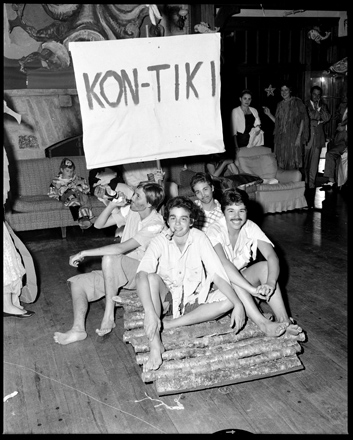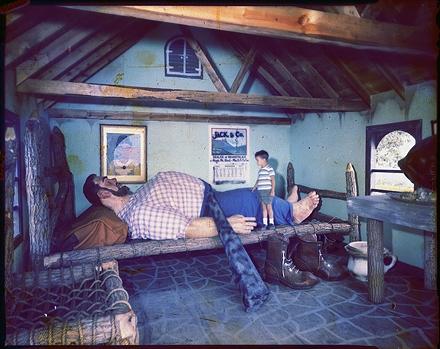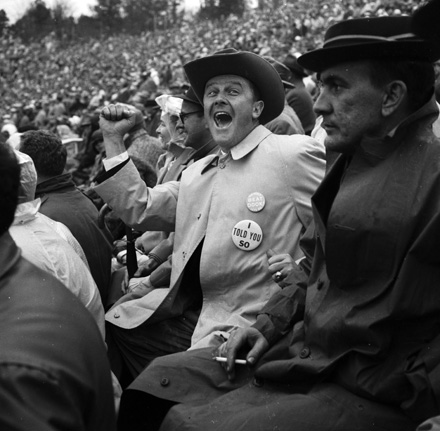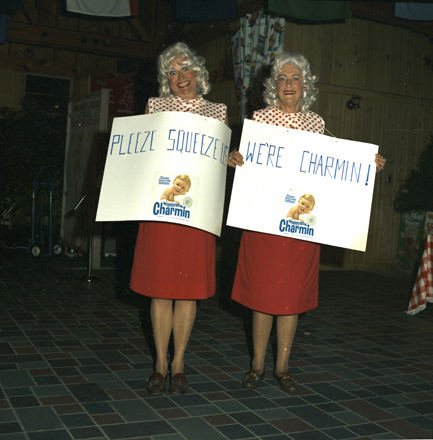
What the heck is going on here? I’m not sure, but I like it. This image is from a set of negatives labeled “Fancy Dress Ball.” From what I can gather, the Ball is an annual event that takes place at the Eseeola Lodge at Linville Golf Club. Attendees dress up in wacky and sometimes incredibly elaborate costumes—or at least they used to. Images from the 2007 Ball on this photo blog seem to indicate that the costumes are a thing of the past. Too bad!
I would love to know more about the origins, history, and purpose of this event, for which Hugh Morton seems to have been an “official” photographer (primarily during the 1960s and 70s). The earliest marked negatives I see so far are from 1958. What can you tell me?
For fun, I’ll include a few more sample images: another from the 1974 Ball, followed by one I think is from the 1950s (though it wasn’t labeled, and may not even be from the Ball at all—I’m just guessing).

Elizabeth Hull
A "Photographer’s Photographer"
One of the many titles bestowed on Hugh Morton over the years is “the father of North Carolina photojournalism education.” He was a charter member of the National Press Photographers Association and president of the North Carolina Press Photographers Association. Appealing to a broader audience, Morton founded in 1952 the annual Grandfather Mountain Camera Clinic for amateurs and professionals, and the Nature Photography Weekend, also hosted by Grandfather Mountain.
Perhaps most notably, Morton was a founder and the first chairman (1950-1965) of the Southern Short Course in Press Photography. Now known as the Southern Short Course in News Photography, this training program for students and professionals is the country’s longest-running seminar in photojournalism. The images below are from the early years of the Short Course, probably 1951-1953, when it was held at the University of North Carolina at Chapel Hill. The first image shows Joseph Costa (left, in bow tie), well-known American newspaper photographer, photography lecturer at Ball State University, and a founder of the National Press Photographers Association; the other man presenting (back to camera) appears to be Hugh Morton. Since most audience members are wearing name tags, this image is handy for identification purposes. (Few of the names are legible, however, and none at the resolution presented here.)
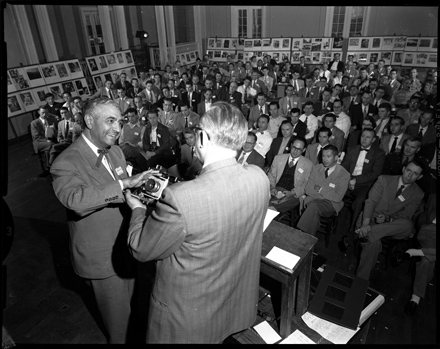
The next image shows unidentified instructors presenting about darkroom procedure. (Sharp-eyed readers of this blog might notice Burlington photographer Edward J. McCauley in the third row, third seat from the left—see Patrick Cullom’s recent post, A Contemporary of Morton).
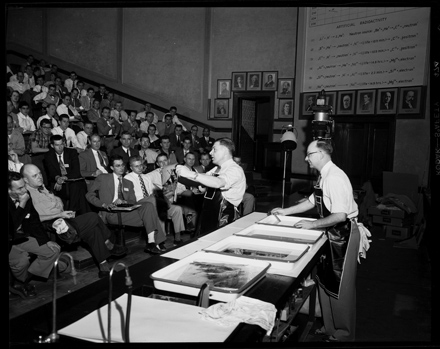
Our blogging compatriot over at the Blue Ridge Blog says, “I’ll always remember Hugh Morton as a photographer’s photographer. He understood the needs of a working photojournalist and went out of his way to make the job easier for us.” Do you have any photojournalism- related memories of Morton to share? Can you provide any information about these early Short Course images?
Happy Holidays
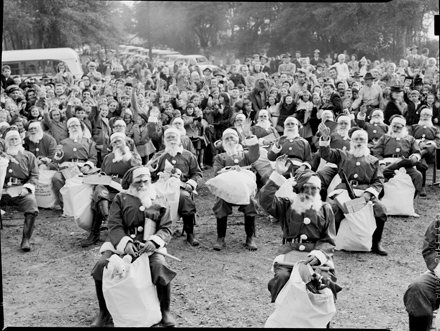
I’m enlisting the help of these waving Santas to wish readers Happy Holidays, and to bid farewell until “A View to Hugh” returns in 2008.
Morton took this photo and many others at Wilmington’s Hilton Park, home of the “Largest Living Christmas Tree”—an oak tree, believed to be more than 400 years old, that has been lit up annually since 1928 (with one break during World War II). The crowd in the image above was presumably gathered for a lighting ceremony, sometime in the late 1940s. The image of carolers below was taken around the same time (this negative has deteriorated some with age).

This last image of the tree itself was taken a bit later, probably in the late 1950s. As always, please let us know if you can provide any information about the scenes/people depicted. Hope these help put you in the holiday spirit!
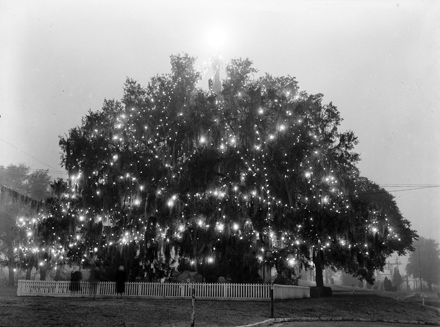
Bear wrestling
In a new article about the Morton photographs from the Fall 2007 issue of UNC Friends of the Library’s Windows Magazine, entitled “Capturing Seven Decades of Life in North Carolina,” author Ginger Travis compares processing the Morton collection to “wrestling a bear.” I find this particularly funny because for the past few days I have been sorting through images of—you guessed it—BEARS!
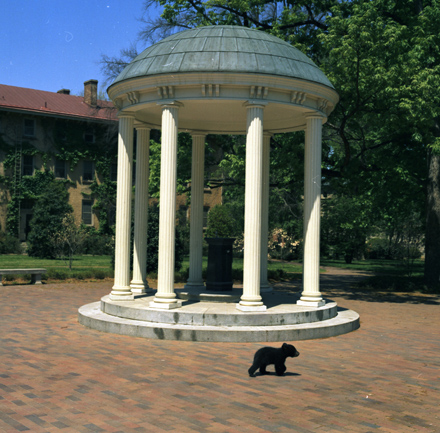 One set of negatives caught my attention early on—a series featuring an adorable black bear cub up to hijinks at various North Carolina landmarks (Biltmore, the State Capitol, the NC Botanical Gardens, Orton Plantation, etc.). Since these film rolls were cut up and scattered throughout the collection, with no identification, I was a bit mystified as to their context. Did Hugh Morton just toss a cub in the car and drive around the state so he could take pictures of it? If so, um. . . why?
One set of negatives caught my attention early on—a series featuring an adorable black bear cub up to hijinks at various North Carolina landmarks (Biltmore, the State Capitol, the NC Botanical Gardens, Orton Plantation, etc.). Since these film rolls were cut up and scattered throughout the collection, with no identification, I was a bit mystified as to their context. Did Hugh Morton just toss a cub in the car and drive around the state so he could take pictures of it? If so, um. . . why?
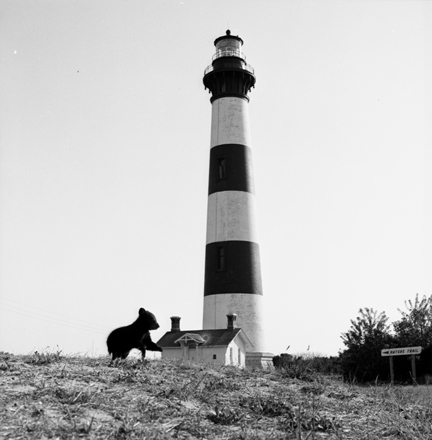 Then, the other day, I came across some of the bear cub negatives in an envelope labeled “Negatives–Zoo Trip with Little Bear–4-72,” in Morton’s hand. So, I’m guessing that Grandfather Mountain gave this bear cub to the North Carolina Zoo in April 1972, and these photos were taken on the (somewhat circuitous) trip to deposit him/her there. Can anyone confirm or deny that? Were the images used in some sort of promotional campaign?
Then, the other day, I came across some of the bear cub negatives in an envelope labeled “Negatives–Zoo Trip with Little Bear–4-72,” in Morton’s hand. So, I’m guessing that Grandfather Mountain gave this bear cub to the North Carolina Zoo in April 1972, and these photos were taken on the (somewhat circuitous) trip to deposit him/her there. Can anyone confirm or deny that? Were the images used in some sort of promotional campaign?

NC's "Immortal Showboat"
 In honor of the recently-opened exhibit, “Showboat”: The USS North Carolina (BB 55), at the North Carolina Museum of History, and since I just happened to be “passing” through this particular batch of negatives, I decided to highlight a few of my favorite Morton images related to the USS North Carolina.
In honor of the recently-opened exhibit, “Showboat”: The USS North Carolina (BB 55), at the North Carolina Museum of History, and since I just happened to be “passing” through this particular batch of negatives, I decided to highlight a few of my favorite Morton images related to the USS North Carolina.
Morton was enlisted in 1960 by his good friend and then-governor Luther Hodges to spearhead the ultimately successful campaign to preserve the battleship as a memorial to World War II veterans. The article “Saving Our Ship” on the USS North Carolina Memorial Web site provides background on the campaign and Morton’s leadership, noting in particular that “Morton’s drive to control the administrative costs of undertaking such a large campaign led to savings such as using his young son on campaign posters rather than paying for a model.” The image below must be a mock-up of one of those posters. [The boy in the image below is not one of Morton’s sons, but there are images in the collection showing Jim Morton holding a model of the USS NC that were possibly used on campaign posters.]
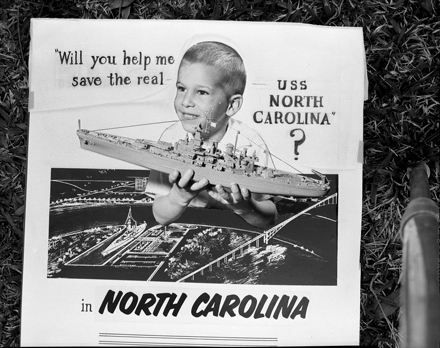
This last image depicts John Weaver working on two busts for the USS NC Museum (likenesses of FDR, Chester Nimitz, MacArthur, and Truman were made—not sure which two these are). [Correction: This is not John Weaver, but a Linville artist named Coffey, and these heads were not created for the USS NC. Just goes to show that an archivist can’t always trust the contextual information that comes with a document! Thanks to Julia Morton for clarifying.]
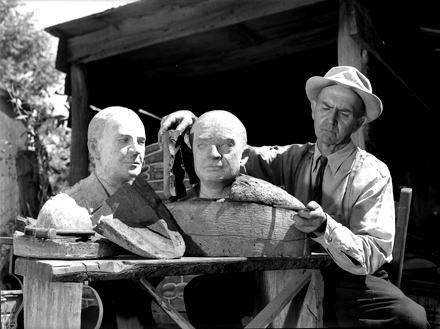
One last note: as I was just proofreading the contents of this post, I happened to notice today’s date: December 6. Tomorrow is the 66th anniversary of the attack on Pearl Harbor. Crazy coincidence strikes again on “A View to Hugh!”
More positive about negatives

I know you will be relieved to hear that I am no longer suffering from the processing anxiety attacks I referred to in my first post. I’m still anxious, but it’s more like continuous fretfulness than bursts of panic.
I am now in the midst of my second “pass” through the Morton negatives. The first pass involved going through the whole lot of them (estimated at 33,000 items—strips, rolls, or individual frames) and sorting roughly by subject (e.g., Grandfather Mountain, Basketball, Hang Gliding, Nature). In my second pass, I’m refining those initial sorts into smaller categories (Grandfather Mountain—Events; Grandfather Mountain—Grounds and Facilities, etc.), getting all loose material into envelopes, and describing the resulting groupings in a spreadsheet. This, I must say, is a pretty satisfying stage—I’m bringing like materials together and starting to build descriptive tools that can be used to navigate the collection. Order is beginning to emerge!
Of course, most of my excitement is squelched when I remember that I’m less than one-third of the way through the second pass, and there’s still a third and probably fourth pass to be completed. Not to mention those pesky prints, transparencies, slides and films that still await attention. Take it easy, Hull. One pass at a time . . .

A "giant" of NC tourism
Hugh Morton’s energetic promotion of travel and tourism in the Southern Appalachians is well known. This High Country Press article provides Spencer Robbins’ first-hand perspective on Morton’s tourism work, which included helping found both the Southern Highlands Attractions Association and the High Country Host. (Please note: the Goodman article reflects personal perceptions of events, and contains at least one inaccuracy when it states that Morton considered a run for governor in the mid-1980s; it was in 1971 that Morton announced his candidacy for the 1972 election, but he dropped out before the primary.)
Morton’s boosterism is definitely reflected in the images he produced. In addition to the hundreds (thousands?) of shots in the collection taken of, on, or around Grandfather Mountain, there are numerous photos of other attractions including outdoor dramas, lighthouses and other coastal landmarks, the Barter Theatre in Virginia, Georgia’s Rock City, The Blowing Rock, Tweetsie Railroad, and the wonderful Land of Oz on Beech Mountain. (Some of these will be featured in a later blog posts, so stay tuned!)
But here’s one we just can’t figure out. This splotchy negative appears to show a re-creation of the giant’s house from the Jack and the Beanstalk story, shown with a real-life boy to provide perspective. The calendar on the wall reads, “Jack & Co. We Grow ‘Em Big! Dealer in Beanstalks at Magic Mt. Blvd. Pho.: Fe Fi Fo Fum.” The date on the calendar (oddly) is “Augustus 1063,” a month which apparently had 33 days. I know the J & B tale is old, but that old?
Part of my fascination with this image is that it seems vaguely familiar, as if I might have visited this place as a kid. Help me out—do you know why, where, when, or of whom this picture was taken?
Battle for the Victory Bell
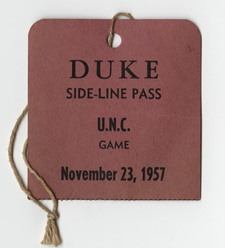 It’s that time of year, and in honor of this Saturday’s UNC-Duke football game, we thought we would revisit the same event 50 years ago: the dramatic November 23, 1957 face-off at Wallace Wade Stadium. UNC coach Jim Tatum had suspended quarterback Dave Reed a few weeks earlier in the season (prior to the Wake Forest game), and “Dook” was expected to win . . . making the Heels’ surprise 21 to 13 victory all the sweeter.
It’s that time of year, and in honor of this Saturday’s UNC-Duke football game, we thought we would revisit the same event 50 years ago: the dramatic November 23, 1957 face-off at Wallace Wade Stadium. UNC coach Jim Tatum had suspended quarterback Dave Reed a few weeks earlier in the season (prior to the Wake Forest game), and “Dook” was expected to win . . . making the Heels’ surprise 21 to 13 victory all the sweeter.
Hugh Morton was on the sidelines, of course, and we have his press pass (above) to prove it. After the game, Morton made a well-known photograph of Coach Tatum embracing an emotional Reed. That photograph is featured on page 168 of the 2003 book Hugh Morton’s North Carolina. The image below shows an enthusiastic but unidentified UNC fan in the stands that day, wearing buttons that read “Beat Dook” and “I Told You So.” Do you know who this is?
Amazing trick photography!
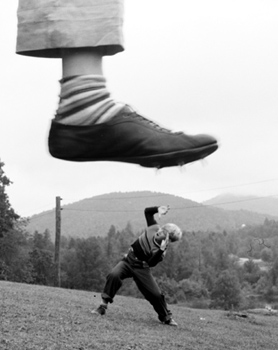 This is one of the more amusing shots I’ve come across so far in the Morton collection (I cropped the version at left for maximum effect). The picture was taken sometime during Hugh’s days at Camp Yonahnoka, where he took his first photography course in 1934 and served the following five summers as the camp’s photography instructor. It’s a good example of Morton’s appreciation for visual humor, something I’ve noticed throughout the collection.
This is one of the more amusing shots I’ve come across so far in the Morton collection (I cropped the version at left for maximum effect). The picture was taken sometime during Hugh’s days at Camp Yonahnoka, where he took his first photography course in 1934 and served the following five summers as the camp’s photography instructor. It’s a good example of Morton’s appreciation for visual humor, something I’ve noticed throughout the collection.
See below for the uncropped version, which shows how this mind-blowing “feat” of perspective was achieved. (Zing!) Just goes to show that some things—including puns—will never stop being funny.
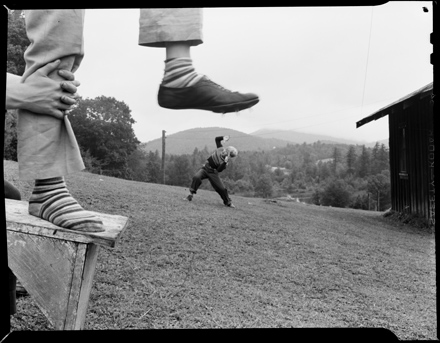
Morton the environmentalist
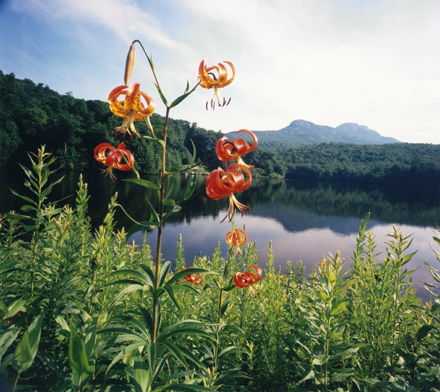 When my good friend who works for the Nature Conservancy in NC heard that I was going to be working on the Morton photos, she could barely contain her glee. Hugh Morton, you must understand, is somewhat of a rock star in environmental and land conservation circles. This lovely eulogy by Morton’s good friend and Appalachian State professor Harvard Ayers (a former professor of mine, actually!) details Morton’s legacy and contributions in these areas—donating thousands of acres of land on Grandfather, championing the Linn Cove Viaduct to “minimize the ecological impact of the Blue Ridge Parkway,” and making the influential 1995 documentary “The Search for Clean Air”—to name just a few.
When my good friend who works for the Nature Conservancy in NC heard that I was going to be working on the Morton photos, she could barely contain her glee. Hugh Morton, you must understand, is somewhat of a rock star in environmental and land conservation circles. This lovely eulogy by Morton’s good friend and Appalachian State professor Harvard Ayers (a former professor of mine, actually!) details Morton’s legacy and contributions in these areas—donating thousands of acres of land on Grandfather, championing the Linn Cove Viaduct to “minimize the ecological impact of the Blue Ridge Parkway,” and making the influential 1995 documentary “The Search for Clean Air”—to name just a few.
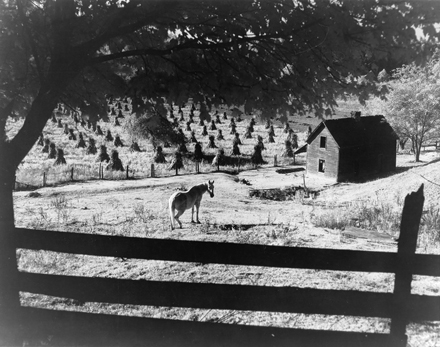 But Morton’s most powerful statements on behalf of nature were his photographs, which he used to great effect to show damage done by pollution and irresponsible development, to document rare and endangered species, and to capture rural life in NC. As these sample images illustrate, his eye for composition and remarkable ability to highlight natural features to their greatest impact made a stronger case for conservation than words could have.
But Morton’s most powerful statements on behalf of nature were his photographs, which he used to great effect to show damage done by pollution and irresponsible development, to document rare and endangered species, and to capture rural life in NC. As these sample images illustrate, his eye for composition and remarkable ability to highlight natural features to their greatest impact made a stronger case for conservation than words could have.
We would love to hear from people who worked with Morton on environmental causes or who saw him in action on this front. Did you attend one of his slide show lectures? When and where? What images stuck with you?

